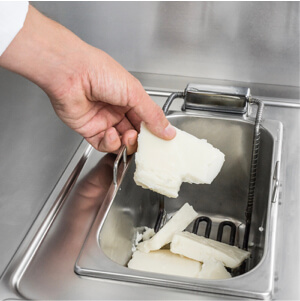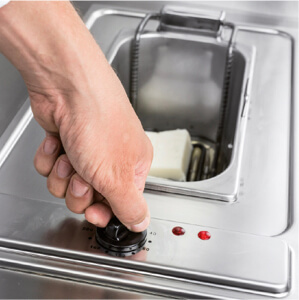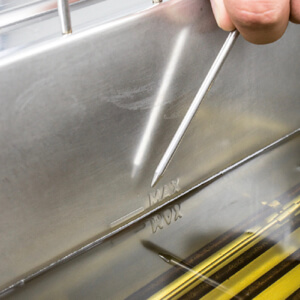Loading the fryer
Loading the fryer with solid fats
Solid fats need to be handled carefully when being introduced into the fryer. Make sure you understand and follow one of the two methods presented on the following pages. Remember that solid fats must be filtered warm because fats solidify as they cool.
- Load the fryer with extreme caution!
- A flash fire may occur if the fryer is not handled properly.
- Only load fryer in full accordance with your management instructions.
Loading solid fats – Method 1



Solid fats should be melted in a separate container before loading in the fryer. Care should be taken while melting fat to avoid overheating. When a sufficient amount of fat has been melted to cover the heating elements of your fry kettle, pour the melted solid fat into the fryer. Turn the heat on and start placing small pieces of solid fat in the fryer until the fill mark of your kettle has been reached.
Loading solid fat – Method 2


An alternative method of melting – though not as beneficial to the fat – is to pack the solid fat around the heating elements before turning the fryer on. Set the fryer thermostat on its minimum setting so you don't scorch the fat. Why does solid fat require so much caution? Fat begins to break down when heated. Fat dropped onto a hot element will smoke and darken. This extreme heat will considerably reduce the performance of the fat, even before you have finished loading the fryer.
Loading the fryer with liquid oils


It is not necessary to melt liquid oils prior to use. Simply pour the oil into the fryer slightly below the full mark before turning on the heat.
To insure proper fryer operation, it is very important to keep the oil quantity at the level specified by the manufacturer of the fryer. A deep fryer is designed to operate at maximum efficiency with a certain amount of oil. When the oil level is too low or too high, uneven frying and excessive browning may occur.
Loading the fryer with solid fats
Solid fats need to be handled carefully when being introduced into the fryer. Make sure you understand and follow one of the two methods presented on the following pages. Remember that solid fats must be filtered warm because fats solidify as they cool.
- Load the fryer with extreme caution!
- A flash fire may occur if the fryer is not handled properly.
- Only load fryer in full accordance with your management instructions.
Loading solid fats – Method 1

Solid fats should be melted in a separate container before loading in the fryer. Care should be taken while melting fat to avoid overheating.

When a sufficient amount of fat has been melted to cover the heating elements of your fry kettle, pour the melted solid fat into the fryer.

Turn the heat on and start placing small pieces of solid fat in the fryer until the fill mark of your kettle has been reached.
Loading solid fat – Method 2

An alternative method of melting – though not as beneficial to the fat – is to pack the solid fat around the heating elements before turning the fryer on. Set the fryer thermostat on its minimum setting so you don't scorch the fat.

Why does solid fat require so much caution? Fat begins to break down when heated. Fat dropped onto a hot element will smoke and darken. This extreme heat will considerably reduce the performance of the fat, even before you have finished loading the fryer.
Loading the fryer with liquid oils

It is not necessary to melt liquid oils prior to use. Simply pour the oil into the fryer slightly below the full mark before turning on the heat.

To insure proper fryer operation, it is very important to keep the oil quantity at the level specified by the manufacturer of the fryer. A deep fryer is designed to operate at maximum efficiency with a certain amount of oil. When the oil level is too low or too high, uneven frying and excessive browning may occur.
